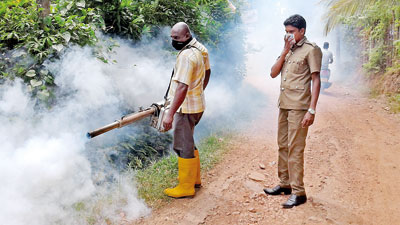News
Thousands of deadly dengue breeding sites still being found
Thousands of dengue mosquito breeding sites are still being found in the country regardless of campaigns to reduce the hundreds of innocent deaths and hundreds of thousands of infections.
Another outbreak is feared with the onset of seasonal rains.
From January to September 21, latest official data show that 154,529 people have been infected with deadly dengue. During the second week of September alone 1,273 dengue patients have been reported. There has been a slight decrease in the recent weeks.
The National Dengue Control Unit says that 390 people have died as September 22.
Consultant Community Physician of the National Dengue Control Unit, Dr. Preshila Samaraweera, told theSunday Times that during the national dengue control week, health officials had inspected 200,000 potential breeding places out of which 4,077 sites tested positive for dengue mosquito larvae.
She said that there was a possibility of another outbreak and mosquito-control campaigns will continue.
“We have added 500 more labourers and they have been trained to carry out dengue activities every day,’’ she said.
Epidemiologist of the Kalutara regional director of health services, said that while people have responded well to dengue control programs, he fears complacency will take over.
In the fourth or sixth week after the rains, it will be possible to know if dengue is re-emerging, he said.
“We are expecting an increase in the number of cases according to the forecasting model in the areas that report a rainfall of more than 100mm,’’ he said.
An early warning plan has been initiated.
Panadura, Horana, Matugama, and Dodangoda have been identified as vulnerable areas for the highest number of dengue cases reported during the previous outbreak.
“While carrying out community level source reduction programmes and household inspections, we will also be focusing on private and public institutions,’’ he said.
The regional director of health services of Jaffna, Dr. K. Nanthakumaran, said an outbreak had not yet happened, but is expected in the next few months.
Prevention activities are continuing despite the public health inspectors’ trade union action in the Northern province due to a transfer issue.
“The dengue week is conducted without PHI participation. We are encouraging community participation with the help of other staff members. Routine programmes are conducted with the support of the police and other forces together with local government institutes,’’ he said.
According to Dr. Nanthakumaran, public awareness is satisfactory although segregation of waste needs to improve.
Dr. Sarath Weerabandara, the Kandy regional director of health services, said public awareness is good.
“The number of cases reported has been reduced by 50% this month compared with previous months. But we have not cut down the number of programmes. Checking for mosquito larvae, household inspections, and fogging are done on a routine basis,’’ he said.
Dr. Weerabandara said that due to the recent heavy showers there is a possibility of another outbreak. But the impact of the outbreak could be reduced through cleaning programmes.
“We have identified Yati Nuwara, Uda Palatha, Kandy, and Kandy Municipal Council areas, Poojapitiya, Kundasale, and Pasbaage as high risk areas according to data collated during the previous outbreak. As a result of which special clean up campaigns have been advised in these areas,’’ he said.
Previous patterns suggest there can be an increase in the number of dengue cases in November and December, Dr Weerabandara said.
The Kegalle regional director of health services, Dr Vijith Gunasekara said a drastic reduction in dengue cases is expected as a result of anti-mosquito programmes.
“The public seemed to be more involved. However, there is a tendency for people to forget. The interest is lost and the whole process comes to a halt. To strengthen the interest in the people, the awareness and health education programmes must be efficient,’’ he said.
| SRI LANKA MAJOR SOURCE OF DENGUE IN HK | |
| Sri Lanka remains the third largest source of dengue infections in Hong Kong, data from Friday show. Sri Lanka accounts for 11 dengue infections out of 78 reported cases this year, Hong Kong’s Centre for Health Protection of the Department of Health, said. The largest number of imported cases come from Thailand, which accounted for 20 infections in Hong Kong, while there were 11 from Philippines. In Asia, so far this year, there have been 37,392 cases in Thailand, and 2,056 infections in Singapore. In China’s southern province, Guangdong, there have been 310 dengue cases this year. Guangdong was the epicentre in the deadly SARS virus outbreak in 2003. In Hong Kong, to prevent mosquito bites, health authorities, recommend using insect repellents containing less than 10% DEET. The chemical name is N, N-diethyl-meta-toluamide. It is used as the active ingredient in many insect repellents. Children should not be allowed to apply such insect repellents by themselves. The US Centers of Disease Control says using insect repellents containing DEET should not be harmful if label directions are followed and the product is used safely. In rare cases, using DEET products may cause skin rashes. More than 10 years ago, the CDC approved alternatives —picaridin and oil of lemon eucalyptus. The National Coalition against the Misuse of Pesticides in the United States also suggests, oil of lemon eucalyptus, as well as products containing geraniol, citronella, herbal extracts, or essential oils. |

